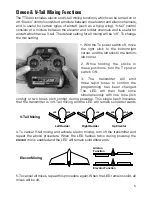
12
●
ALWAYS
make sure that all transmitter stick movements operate all servos
properly in the model. Check the proper operation of control surfaces before and
after starting the motor.
●
Do not store your radio equipment in extremely hot or cold locations, in
direct sunlight, or in locations with high humidity. Store R/C equipment in cool
and dry locations.
●
Do not allow chemicals to come in contact with any parts of the radio system.
Substances such as glow fuel, gasoline, CA glue, etc. could permanently damage
plastic parts of the radio system.
●
If NiCd batteries were installed in the transmitter, remove the batteries before
placing the radio in long-term storage.
TROUBLESHOOTING
Range is Short
Interference – check Rx antenna installation. Rx may need to be located to a
different position in the model for better reception. Low Tx or Rx battery – replace
the batteries or recharge if applicable. Crash damage – send the radio to Hobby
Services for repair.
Run Time is Short
Low Tx or Rx batteries – replace or recharge the batteries. Obstructed servo
linkages causing excess battery drain – free the linkages / pushrods.
Tx Power Switch On But Servos Do Not Function
Tx or Rx batteries are low – replace or recharge the batteries. Power is not applied
to the Rx – re-apply adequate power to the Rx. Rx is not linked to the Tx properly
– perform linking process again.
Interference or Servos Glitching
Out of range – operate the model more closely to the Tx. Outside radio interference
from pagers, strong industrial or other commercial transmitters in the area - check
your local R/C club regarding local operation.
Control Surface Moves in the Wrong Direction
Reverse the direction of movement of the affected channel in the setup of the Tx.
Internal Charger Does Not Recognize Battery
Make sure battery is connected properly. Check for faulty connection or wiring.
Replace battery.


































